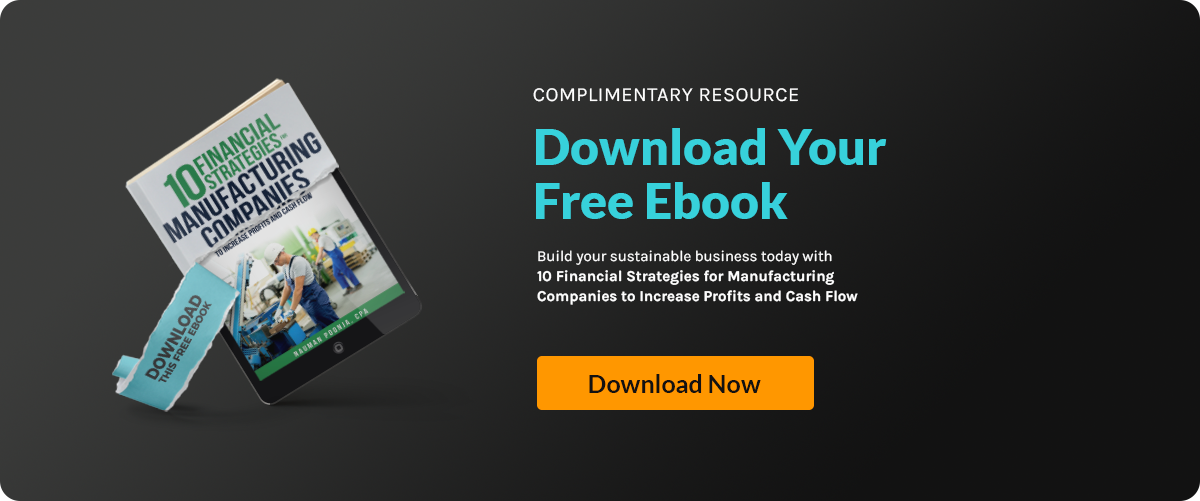Did you know that most manufacturing companies only make about 8% profit on what they sell? That’s...
Revenue vs. Profit Explained: Why Many Business Owners Get It Wrong

Ask any founder how their business is doing, and you’ll often hear, “We made great revenue this year.” But when you look closer, the numbers tell another story—high sales, low profit, and shrinking cash.
This confusion between revenue and profit is one of the most common (and costly) mistakes in manufacturing. Revenue looks exciting, but it’s profit that keeps your company alive.
In this guide, we’ll clarify the difference, show how both metrics connect, and explain how understanding them like a CFO leads to smarter, more sustainable growth.
Why Founders Mix Up Revenue and Profit
Entrepreneurs, especially in manufacturing, focus on top-line numbers—sales, contracts, and purchase orders. These reflect customer demand and success.
But while revenue measures momentum, profit measures efficiency. You can double revenue and still lose money if your costs rise faster than sales.
This confusion often comes from:
- Prioritizing growth over margins
- Overlooking production inefficiencies
- Ignoring hidden expenses
- Relying on outdated reporting methods
As explored in what a CFO does in a manufacturing company, strong financial leadership focuses on both: growing revenue and converting it efficiently into profit.
Revenue: The Top Line
Revenue represents your total income from selling products or services before subtracting any expenses.
For manufacturers, that includes:
- Product sales to distributors or retailers
- Custom orders or contract manufacturing
- Licensing or design fees
CFOs view revenue as the measure of scale, not success. A higher top line doesn’t automatically mean your business is healthier.
Understanding your revenue trends helps you track demand, pricing, and production capacity. But revenue is only one side of the financial story.
Profit: The Bottom Line
Profit is what remains after all costs are deducted from revenue. It shows how efficiently your business turns income into earnings.
Types of Profit Every Founder Should Know
-
Gross Profit – Revenue minus cost of goods sold (COGS). This reflects production efficiency.
-
Operating Profit – Gross profit minus overhead like rent, utilities, and salaries.
-
Net Profit – What’s left after interest, taxes, and all other expenses.
Manufacturing leaders should also monitor their contribution margin , how much each product contributes to covering fixed costs and generating profit.
Profit reveals your company’s true performance, while revenue alone only shows potential.
Key Differences Between Revenue and Profit
| Factor | Revenue | Profit |
|---|---|---|
| Definition | Total income from sales | Remaining income after all costs |
| Indicator of | Growth potential | Efficiency and sustainability |
| Focus | Top line | Bottom line |
| Controlled by | Sales and marketing | Operations, finance, and cost control |
| Common Misunderstanding | “High revenue = high success” | Profit determines long-term viability |
Both are vital, but profit tells the truth about growth.
Why Focusing on Revenue Alone Can Mislead You
1. Hidden Costs
Manufacturing involves variable expenses—materials, labor, energy, and maintenance. Without close monitoring of fixed and variable costs, high sales can mask low profitability.
2. Pricing Gaps
Discounting to boost revenue often erodes margins. A small price reduction can cut profit drastically if your margin analysis isn’t accurate.
3. Poor Cash Flow
You can have impressive sales but no liquidity. Customers paying late create a gap between paper profit and available cash. Learn how to fix it in effective cash flow strategies every manufacturer needs.
4. Overinvestment
Expanding production capacity too quickly based on high revenue projections can strain cash reserves. Sustainable scaling requires clear profit targets, not just sales goals.
The Relationship Between Revenue, Cost, and Profit
CFOs often visualize this as a flow:
Revenue → Costs → Profit
- Revenue fuels the system.
- Costs consume part of that energy.
- Profit is what remains for reinvestment or growth.
To maintain this balance, manufacturers track performance using financial KPIs such as gross margin percentage, return on investment, and cash conversion cycle.
The Role of Financial Statements
Understanding the distinction between revenue and profit starts with your financial reports.
-
The income statement shows both revenue and profit.
-
The balance sheet reveals how profits accumulate into retained earnings.
-
The cash flow statement connects earnings to liquidity.
Learn how to interpret these like a CFO in how to read financial statements like a CFO.
How CFOs Think About Growth
CFOs treat revenue as potential energy and profit as usable energy.
They look for alignment between sales growth and margin improvement. If revenue rises 30% but gross margin drops 10%, something’s wrong—likely in pricing, production, or purchasing.
This holistic view, combining forecasting and analysis, is what drives sustainable expansion, as discussed in financial modeling vs forecasting for growth.
Why Profitability Defines Real Growth
Growth without profit creates instability. Manufacturers who chase revenue often end up cash-poor, asset-heavy, and vulnerable to market swings.
Profitability ensures resilience—it funds R&D, automation, and talent retention. It also makes your company more attractive to investors and lenders.
This balance between top-line and bottom-line performance forms the basis of strategic financial planning in manufacturing.
Strategies to Improve Profit Without Killing Revenue
1. Refine Pricing Models
Price intelligently using cost-volume-profit analysis. Small adjustments to pricing or discount structures can significantly raise margins.
2. Optimize Cost Structure
Audit direct and indirect expenses regularly. Adopt methods from improving inventory efficiency through cost optimization.
3. Automate Financial Workflows
Implement automation tools that track performance in real time. See how this transforms operations in how accounting automation improves manufacturing finance.
4. Strengthen Forecasting
Combine historical data with forward-looking analysis to maintain balance between revenue targets and profit goals. Learn techniques in manufacturing financial forecasting.
5. Monitor KPIs Continuously
Regularly compare profit margins, return on assets, and debt ratios to identify inefficiencies early.
Real Example
A custom furniture manufacturer reported record sales in 2024—up 45% from the prior year. Yet profits fell by 12%.
A deeper review revealed increased raw material costs and overproduction tied up in inventory. After implementing financial health checks and tighter production budgeting, they restored profitability within two quarters—proving that sales volume means little without disciplined cost control.
How to Align Teams Around Profit, Not Just Revenue
- Sales: Incentivize deals that meet minimum margin thresholds.
- Operations: Focus on reducing waste and downtime.
- Finance: Provide visibility into real-time profitability data.
- Leadership: Communicate profit goals as clearly as revenue targets.
Cross-department alignment ensures everyone contributes to profitable growth, not just sales growth.
Metrics Every Founder Should Track
| Metric | Purpose | Insight Provided |
|---|---|---|
| Gross Margin % | Profitability of production | Reveals pricing and efficiency balance |
| Operating Margin % | Cost efficiency | Highlights overhead management |
| Net Profit Margin | True profitability | Indicates sustainable success |
| Revenue Growth Rate | Sales expansion speed | Measures demand and market reach |
| Cash Flow Ratio | Liquidity strength | Measures stability under growth |
By analyzing these metrics regularly, founders transition from reactive decision-making to strategic financial control.
Common Misconceptions
-
“If we sell more, we’ll make more profit.”
Not always. Costs often rise with volume. -
“Profit is just accounting numbers.”
Profit reflects real cash flow—critical for reinvestment. -
“Revenue growth equals business health.”
Without profit, growth is fragile. -
“Profit means we have cash to spend.”
Timing differences between revenue recognition and payment collection can create cash gaps.
Avoiding these misconceptions protects your bottom line and keeps financial decisions grounded in facts.
The CFO Mindset for Founders
CFOs evaluate every decision by its effect on profit, not just revenue. When founders adopt that mindset, they build businesses that scale sustainably.
They:
- Forecast revenue with caution and validate it with real data.
- Track contribution margins for every product line.
- Reinvest profits strategically into operations, not vanity metrics.
Profit-focused leadership transforms growth from chaotic to predictable.
The Bottom Line
Revenue shows activity. Profit shows results. Successful manufacturers understand both—and manage the relationship between them.
To build a strong, scalable business, focus less on top-line celebration and more on bottom-line discipline. The companies that master this balance thrive, even when markets fluctuate.
Ready to understand your numbers like a CFO?
Contact Accounovation to gain financial clarity, boost profitability, and turn your revenue into real business growth.







